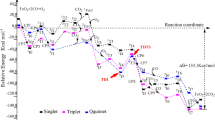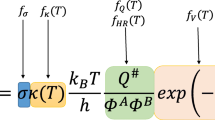Abstract
In every oxidation reaction two reactants take part: oxygen and the molecule to be oxidized. The reaction may thus start either by activation of the dioxygen (electrophilic oxidation) or by activation of the hydrocarbon molecule (nucleophilic oxidation). The surface of an oxide catalyst for selective oxidation must thus be tailored to perform a complex multistep operation on the reacting molecules, at the same time hindering those interactions that could lead to unwanted byproducts.
A theoretical description of chemical reactions may be attempted on the basis of the concept of the potential energy hypersurface for molecular motions. The minima on such a hypersurface correspond to stable systems; i.e., to reactants and products of the reaction network investigated. As the networks for the oxidation of hydrocarbons on oxide surfaces are relatively large systems, even the semiempirical computation is time-consuming and further simplifications of the model must be adopted to make full description feasible. Analysis of experimental data suggests that as the form of the transition state is already determined at the preliminary stage of the reaction, the energy gradient estimated from the difference of total energies at two points chosen at relatively large distances between the reactants may be taken as an indication of the potential barrier encountered on approach from a given direction. Thus, reaction pathways characterized by the lowest energy barriers may then be analyzed.
Calculations were carried out for the reaction pathways in the system composed on non-activated and activated butene interacting with molecular or atomic oxygen. A general conclusion may be formulated that the important functions of active centers of the oxidation catalyst consist in the adsorption of the reacting molecules in the appropriate mutual orientation and in modification of their relative electrophilic-nucleophilic character.
Similar content being viewed by others
References
J. Haber,Proc. 8th Int. Congr. Catalysis, Berlin 1984 (Verlag Chemie-Dechema, Frankfurt, 1984) Vol. 1: Plenary Lectures, p. 85.
J. Haber, Architecture of oxide catalysis, in:Perspectives in Catalysis, eds. J.M. Thomas and K. Zamaraiev (Blackwells Publ. Co, Oxford, 1991).
B. Grzybowska-Swierkosz, Mater. Chem. Phys. 17 (1987) 121.
S. Malinowski and K. Marczewski, Specialist Periodical Rep., Catalysis, Vol. 8 (The Royal Soc. Chem. London, 1985).
J. Haber, in:Structure and Reactivity of Surfaces, eds. C. Morterra, A. Zecchina and G. Costa (Elsevier, 1989) p. 447.
J. Haber, in:The Role of Solid State Chemistry in Catalysis, ACS Symposium Ser. No. 279 (American Chemical Soc., Washington D.C., 1985) p. 3.
A. Bielanski and J. Haber, Catal. Rev. 19 (1979) 1.
G.C.A. Schuit,Proc. 1st Int. Conf. Chemistry and Uses of Molybdenum, Reading, 1973, ed. P.C.H. Mitchell (Climax Molybdenum Co, London, 1974) p. 175.
K. Bruckman, J. Haber and T. Wiltowski, J. Catal. 102 (1986) 52.
J. Haber and T. Wiltowski, Bull. Acad. Polon. Sci., ser. sci. chim. 29 (1983) 563.
J. Haber,Proc. 4th Int. Conf. Chemistry and Uses of Molybdenum, Golden Colorado, 1982, eds. H.F. Barry and P.C.H. Mitchell (Climax Molybdenum Co, Ann Arbor, 1982) p. 395.
T. Machej and J. Ziolkowski, J. Solid State Chem. 31 (1980) 135.
G.W. Hearne and M.L. Adams, US Patent 2 383 711 (1945).
G. Centi and F. Trifiro, Appl. Catal. 12 1984) 1.
K. Fukui, J. Phys. Chem. 74 (1970) 4161.
W.H. Miller, N.C. Handy and J.E. Adams, J. Chem. Phys. 72 (1980) 99.
Z. Havlas and R. Zahradnik, Int. J. Quant. Chem. VXXVI (1984) 607.
E. Brocławik, Acta Phys. Polon., in press.
M.J.S. Dewar and W. Thiel, J. Am. Chem. Soc. 99 (1977) 4899, 4907.
R. Fletcher and M.J.D. Powell, Comput. J. 6 (1963) 163.
W.C. Dawidson, Comput. J. 10 (1968) 406.
E. Brocławik, M. Witko, J. Haber and Wang Ren-Hu, J. Mol. Catal, in press.
J. Haber and M. Witko, Acc. Chem. Res. 14 (1981) 1.
Author information
Authors and Affiliations
Rights and permissions
About this article
Cite this article
Haber, J., Witko, M. On the molecular mechanism of catalytic oxidation of olefins. Catal Lett 9, 297–309 (1991). https://doi.org/10.1007/BF00773187
Issue Date:
DOI: https://doi.org/10.1007/BF00773187




